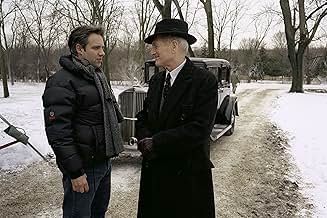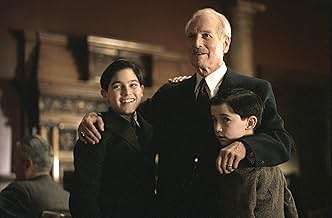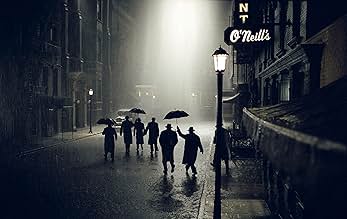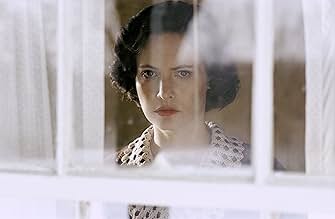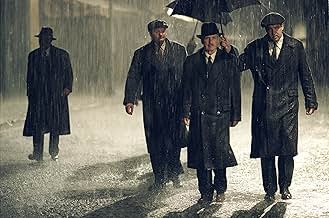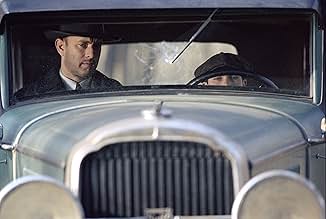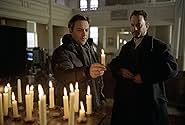1930 के दशक में इलिनोइस में एक भीड़ का बेटा एक हत्या का गवाह बना।1930 के दशक में इलिनोइस में एक भीड़ का बेटा एक हत्या का गवाह बना।1930 के दशक में इलिनोइस में एक भीड़ का बेटा एक हत्या का गवाह बना।
- 1 ऑस्कर जीते
- 23 जीत और कुल 82 नामांकन
Stephen P. Dunn
- Finn McGovern's Henchman
- (as Stephen Dunn)
कहानी
क्या आपको पता है
- ट्रिवियाFor the bank robberies sequence, Tyler Hoechlin (Michael Sullivan, Jr.) had to learn to drive, something he was only too happy to do. Hoechlin mastered it all easily, but, just to be on the safe side, a stunt driver was sitting in the back, with his own set of driving controls.
- गूफ़In that era, gentlemen removed their hats indoors, particularly in places like diners. Even not-so gentlemen. To not do so would have attracted attention.
- भाव
Michael Sullivan, Jr.: So when do I get my share of the money?
Michael Sullivan: Well... how much do you want?
Michael Sullivan, Jr.: Two hundred dollars.
Michael Sullivan: Okay. Deal.
[Michael Jr. stops eating and thinks for awhile]
Michael Sullivan, Jr.: Could I have had more?
Michael Sullivan: You'll never know.
- क्रेज़ी क्रेडिटThanks to all at the Donmar Warehouse Theatre, London
- कनेक्शनFeatured in The Making of 'Road to Perdition' (2002)
- साउंडट्रैकWhose Honey Are You?
Music by J. Fred Coots (as Fred J. Coots)
Lyrics by Haven Gillespie
Performed by Ruth Etting
Courtesy of Take Two Records
फीचर्ड रिव्यू
Ever since Coppola's "The Godfather" came out in 1972, just about every auteur director working in America seems to have cherished the ambition to produce his own "Godfather", hence crime epics like Scorsese's "Goodfellas", Leone's "Once Upon a Time in America", De Palma's remake of "Scarface", the Coen brothers' "Miller's Crossing" and Tarantino's "Pulp Fiction". Following his acclaimed first film "American Beauty", Sam Mendes obviously decided that the it was time to make his own "Godfather", because his second film, "Road to Perdition" is a gangster drama in this tradition.
Michael Sullivan junior is a twelve-year-old schoolboy from Rock Island, Illinois. Although it is the early 1930s, the time of the Great Depression, the Irish-American Sullivan family enjoys a comfortable upper-middle-class existence. Young Michael, however, is puzzled about what his father, Michael senior, actually does for a living; all he knows is that he works for John Rooney, a seemingly respectable elderly gentleman who treats the boy like an adopted grandson. The truth, however, is that Rooney is an organised crime boss and Michael senior his "enforcer" When young Michael stumbles on the truth, after witnessing Rooney's unstable son Connor killing another gang member, he inadvertently puts himself and his family in danger. In an attempt to eliminate the boy, Connor murders his mother Annie and younger brother Peter, forcing Michael and his father to flee for their lives. The rest of the film deals with Michael senior's search for revenge for the deaths of Annie and Peter.
The title can be understood on a number of levels. On the most literal, Perdition is a town to which some of the characters travel at the end of the film. On another level, "perdition" can be interpreted as meaning "death" or "destruction", and on a third "eternal damnation". Perhaps the film's bleakest moment comes when Rooney says to Michael senior that "none of us have any hope of getting to Heaven". This is not just a figure of speech. Rooney is a practising Catholic who has nevertheless embarked upon a way of life which he believes can only result in his damnation to Hell. The film's emphasis on the futility and sterility of the criminal lifestyle is reminiscent of that great British gangster movie, "Get Carter".
The bleakness of the film's moral message is emphasised by its visual style, dominated by a muted palette with dark backgrounds and dull greens and greys. Filming took place in winter and early spring, often against a backdrop of snow and rain; Mendes intended the cold, bleak look of the film to reflect the characters' emotional states. Water, snow and ice are recurrent visual images throughout, from the snowy opening funeral scene with a corpse on ice to the closing scenes by Lake Michigan. The film's emotional impact is also heightened by Thomas Newman's evocative, elegiac musical score.
The film's two most important characters are Michael senior and Rooney, who loves Michael like a son, and yet tries to kill him to save his biological son Connor. In some ways the audience can sympathise with Michael, a man who has suffered unjustly through the deaths of two innocent family members, and this sense of identification is strengthened by the casting of Tom Hanks, an actor normally seen as sympathetic characters. On another level, however, we recognise Michael's moral responsibility for his own predicament as one of those who live by the sword and are therefore doomed to die by the sword as each killing fuels the cycle of revenge and leads to yet more bloodshed. This is one of Hanks's most accomplished performances as he is able to show both these sides of Michael's personality. One of his redeeming characteristics is his love for his son, who he hopes will be able to lead a better life than the one he himself has led, and the film ends on a note of hope in this regard.
This was to be Paul Newman's last appearance in a feature film, and it was to be a fine end to his distinguished career. Although Rooney is a lifelong villain, he is not wholly evil, but a tired, disillusioned old man, in Wilfred Owen's phrase a "devil sick of sin", who retains enough moral awareness to realise that his false system of values has blighted his life and the lives of others. The other notable performance comes from an almost unrecognisable Jude Law as Harlen Maguire, the hit-man sent by Rooney to kill Sullivan. Maguire also works as a crime-scene photographer, and the relish with which he photographs murder victims reveals a macabre fascination with death. In his remorselessness Maguire recalls Anton Chigurh, the hit-man played by Javier Bardem in "No Country for Old Men", although to my mind Law gives a better performance than Bardem. Maguire, for all his evil, is a recognisable human being whereas the one-dimensional Chigurh seems more like a personification of some abstraction such as "death" or "fate".
The "my own Godfather" syndrome means that the organised crime epic has become something of an overcrowded field in the last forty years, but I must say that "Road to Perdition" is one of the most impressive entries in that field. I was impressed by Conrad Hall's breathtaking cinematography, by the standards of acting and by an intelligent script with its themes of father-son relationships, of the ethics of revenge and of the consequences of violence. Above all I was impressed by Mendes's ability to weave all these elements into a mythic whole, an epic which manages to say something new in the otherwise clichéd gangster genre. When I reviewed "American Beauty" I said that Mendes had joined that elite group of directors (Orson Wells, Sidney Lumet, Bryan Forbes, Stuart Rosenberg) who had made a masterpiece with their first film. With "Road to Perdition" he has joined that even smaller group who have made masterpieces with their first two films. 9/10
Michael Sullivan junior is a twelve-year-old schoolboy from Rock Island, Illinois. Although it is the early 1930s, the time of the Great Depression, the Irish-American Sullivan family enjoys a comfortable upper-middle-class existence. Young Michael, however, is puzzled about what his father, Michael senior, actually does for a living; all he knows is that he works for John Rooney, a seemingly respectable elderly gentleman who treats the boy like an adopted grandson. The truth, however, is that Rooney is an organised crime boss and Michael senior his "enforcer" When young Michael stumbles on the truth, after witnessing Rooney's unstable son Connor killing another gang member, he inadvertently puts himself and his family in danger. In an attempt to eliminate the boy, Connor murders his mother Annie and younger brother Peter, forcing Michael and his father to flee for their lives. The rest of the film deals with Michael senior's search for revenge for the deaths of Annie and Peter.
The title can be understood on a number of levels. On the most literal, Perdition is a town to which some of the characters travel at the end of the film. On another level, "perdition" can be interpreted as meaning "death" or "destruction", and on a third "eternal damnation". Perhaps the film's bleakest moment comes when Rooney says to Michael senior that "none of us have any hope of getting to Heaven". This is not just a figure of speech. Rooney is a practising Catholic who has nevertheless embarked upon a way of life which he believes can only result in his damnation to Hell. The film's emphasis on the futility and sterility of the criminal lifestyle is reminiscent of that great British gangster movie, "Get Carter".
The bleakness of the film's moral message is emphasised by its visual style, dominated by a muted palette with dark backgrounds and dull greens and greys. Filming took place in winter and early spring, often against a backdrop of snow and rain; Mendes intended the cold, bleak look of the film to reflect the characters' emotional states. Water, snow and ice are recurrent visual images throughout, from the snowy opening funeral scene with a corpse on ice to the closing scenes by Lake Michigan. The film's emotional impact is also heightened by Thomas Newman's evocative, elegiac musical score.
The film's two most important characters are Michael senior and Rooney, who loves Michael like a son, and yet tries to kill him to save his biological son Connor. In some ways the audience can sympathise with Michael, a man who has suffered unjustly through the deaths of two innocent family members, and this sense of identification is strengthened by the casting of Tom Hanks, an actor normally seen as sympathetic characters. On another level, however, we recognise Michael's moral responsibility for his own predicament as one of those who live by the sword and are therefore doomed to die by the sword as each killing fuels the cycle of revenge and leads to yet more bloodshed. This is one of Hanks's most accomplished performances as he is able to show both these sides of Michael's personality. One of his redeeming characteristics is his love for his son, who he hopes will be able to lead a better life than the one he himself has led, and the film ends on a note of hope in this regard.
This was to be Paul Newman's last appearance in a feature film, and it was to be a fine end to his distinguished career. Although Rooney is a lifelong villain, he is not wholly evil, but a tired, disillusioned old man, in Wilfred Owen's phrase a "devil sick of sin", who retains enough moral awareness to realise that his false system of values has blighted his life and the lives of others. The other notable performance comes from an almost unrecognisable Jude Law as Harlen Maguire, the hit-man sent by Rooney to kill Sullivan. Maguire also works as a crime-scene photographer, and the relish with which he photographs murder victims reveals a macabre fascination with death. In his remorselessness Maguire recalls Anton Chigurh, the hit-man played by Javier Bardem in "No Country for Old Men", although to my mind Law gives a better performance than Bardem. Maguire, for all his evil, is a recognisable human being whereas the one-dimensional Chigurh seems more like a personification of some abstraction such as "death" or "fate".
The "my own Godfather" syndrome means that the organised crime epic has become something of an overcrowded field in the last forty years, but I must say that "Road to Perdition" is one of the most impressive entries in that field. I was impressed by Conrad Hall's breathtaking cinematography, by the standards of acting and by an intelligent script with its themes of father-son relationships, of the ethics of revenge and of the consequences of violence. Above all I was impressed by Mendes's ability to weave all these elements into a mythic whole, an epic which manages to say something new in the otherwise clichéd gangster genre. When I reviewed "American Beauty" I said that Mendes had joined that elite group of directors (Orson Wells, Sidney Lumet, Bryan Forbes, Stuart Rosenberg) who had made a masterpiece with their first film. With "Road to Perdition" he has joined that even smaller group who have made masterpieces with their first two films. 9/10
- JamesHitchcock
- 23 मार्च 2012
- परमालिंक
टॉप पसंद
रेटिंग देने के लिए साइन-इन करें और वैयक्तिकृत सुझावों के लिए वॉचलिस्ट करें
विवरण
- रिलीज़ की तारीख़
- कंट्री ऑफ़ ओरिजिन
- आधिकारिक साइट
- भाषा
- इस रूप में भी जाना जाता है
- Camino a la perdición
- फ़िल्माने की जगहें
- उत्पादन कंपनियां
- IMDbPro पर और कंपनी क्रेडिट देखें
बॉक्स ऑफ़िस
- बजट
- $8,00,00,000(अनुमानित)
- US और कनाडा में सकल
- $10,44,54,762
- US और कनाडा में पहले सप्ताह में कुल कमाई
- $2,20,79,481
- 14 जुल॰ 2002
- दुनिया भर में सकल
- $18,10,01,478
- चलने की अवधि1 घंटा 57 मिनट
- रंग
- ध्वनि मिश्रण
- पक्ष अनुपात
- 2.35 : 1
इस पेज में योगदान दें
किसी बदलाव का सुझाव दें या अनुपलब्ध कॉन्टेंट जोड़ें





